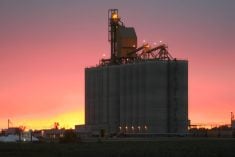While the downsizing of the
Canadian beef herd continues, in my uneducated guess it must be getting near the bottom. And I say that simply because I also read the U.S. beef industry is at least showing the first signs of rebuilding and in past experience, the Canadian industry usually tracks just a few months behind what the U. S industry does.
It is too early to break out the champagne, but I guess the other clear signal that Jerry Klassen (market report on Page 41) and others talk about is prices. As the market strengthens that’ll encourage a few people to at least hold on to, and perhaps increase the number of breeding females in the herd.
Read Also

Cancer agency reclassifies another herbicide ‘probably carcinogenic’
The WHO’s cancer research agency has now put atrazine, a herbicide well known to corn growers, in the same potential-hazard category where the agency put glyphosate.
Manitoba producer Fred Alksnis, who runs a small beef herd near Rorketon, northeast of Dauphin, called the other day to get my inside scoop on the future of the Canadian beef industry. “Is there opportunity for guys like me, or am I just kidding myself?” he asked. And drawing on the amazing insight and experience I have from decades as an industry observer I very emphatically told him, “I don’t know.” And you can take that to the bank.
I suspect Alksnis is like many beef producers who are still at it, or may have exited the business in the last couple years. He’s 50, has a relatively small herd (87 head), and works off the farm to make ends meet.
Beef prices are good right now, the trouble is he ran out of calves to sell. Alksnis says he is operating farm machinery “that is old enough to be collecting pension,” and drives a $1,000 pickup truck, so he’s not one of the glamour cowboys running around in a $60,000 rig.
He is tired of politicians from all parties who say, “they are” the voice of rural Canada. He would like to see the Bloc Quebecois run some candidates in Western Canada just so he can say in his lifetime, “he voted for all the devils.”
“Politicians say they speak for rural Canada, well the voice of rural Canada is getting pretty quiet,” says Alksnis. “I am sitting here at my place with a view of Dauphin Lake with Riding Mountain in the background — it is a million-dollar view, yet I look around and a lot of people in this area have quit farming and ranching. There are lots of farms for sale.
“I see there are programs available to help young farmers to get into business, which is good, but what about the old guys who have hung in here since BSE? What is there to keep them in the industry?”
Alksnis, who still has a pretty good sense of humour, says while beef prices have improved, it is only a matter of time before the price of inputs — fertilizer, fuel, machinery parts — increases too. His cattle graze corn and hay out on pasture most of the winter. He is trying to be as efficient as possible, but the big question is where does he go from here? Should he sell out, should he keep working the night shift helping someone else calve out their cows, should he borrow against that million dollar view to expand his own beef herd and run the risk of still having a mortgage at 65? Where does he go from here?
While I have the magic formula answer in my back pocket, it would also be good to hear from other producers what they see as the answer to this question. Send me your thoughts or comments, and I will put them all together in a plan of action, or if that doesn’t really work, at least include your address and I’ll send you aGrainewscap — they’re priceless.
My contact information is on the right-hand side of the page, under the cartoon.
Lee Hart
INDUSTRY STILL SHRINKING
I “borrowed” this radio report from Kevin Hursh, Saskatchewan reporter and communications specialist, who recently did a recap of a Statistics Canada report on beef numbers as of early 2011. It was all interesting but I took particular note of the fact that across the country, there are over 67,000 cow-calf operations, making for an average herd size of only 57 cows per farm.
Overall, the beef cow breeding herd in Canada continues to drop, but it isn’t dropping as quickly in Saskatchewan as in other parts of the country, Hursh reports.
Statistics Canada reports the number of beef cows in the country as of January 1 is pegged at 4.273 million, a decline of 2.7 per cent from a year earlier. Since the peak back in 2005, the beef cow inventory has dropped over 19 per cent.
The biggest decline over those years has been in British Columbia. They’re down 37 per cent. The smallest decline since 2005 has been in Saskatchewan. We’re down just over 15 per cent.
Alberta’s cow numbers have declined by 20 per cent, but they still have nearly 40 per cent of the national herd. Saskatchewan’s share of the national total has increased to nearly 31 per cent. No. 3 is Manitoba at just under 12 per cent, followed by Ontario at about 7.5 per cent.
PEACE REGION WAS TOO DRY
The Canadian Cattlemen’s Association (CCA) welcomes an announcement by the federal and Alberta provincial governments to provide emergency assistance for livestock producers in the Peace Region, where prolonged dry conditions have resulted in severe feed shortages.
CCA President Travis Toews said several years of drought and dry conditions throughout the Peace Region have made it extremely tough for livestock producers in the area.
“The cost of transporting feed to the cattle or the cattle to areas that have adequate feed supplies can be prohibitive even for the best managed operations,” Toews said. “This emergency assistance will help to somewhat ease the cost pressures of feed shortages caused by drought.”
Announced by Federal Agriculture Minister Gerry Ritz and Alberta Agriculture and Rural Development Minister Jack Hayden, the 2010 Canada-Alberta Feed Transportation Assistance Initiative will help livestock producers with transportation costs for accessing feed for their breeding herds.
Provided through AgriRecovery, the assistance will help affected producers in Alberta’s Peace Region cover some of the costs of transporting forage and feed to their breeding herds or to transport their breeding herds to areas with a more abundant feed supply.
SASKATCHEWAN TOO WET
Relief is on the way for Saskatchewan livestock producers dealing with feed shortages due to excess moisture. This joint effort by federal and Saskatchewan provincial governments through the AgriRecovery initiative will work with the existing Saskatchewan Feed and Forage Program (SFFP) to provide up to $30 per ton to purchase feed.
Assistance is also available to those producers who have to transport feed to their livestock or transport livestock to alternative locations for feeding or grazing due to feed shortages caused by excess moisture.
Saskatchewan producers who own or lease, custom graze or custom-feed breeding livestock are eligible to apply for this new assistance. Eligible breeding livestock include beef and dairy cattle, bison, elk, horses, sheep, goats, deer, reindeer, caribou, llamas and alpacas held in inventory as of October 1, 2010. The SFFP also provides $30 per eligible acre to producers to reseed hay, forage or pasture land that has been damaged by excess moisture.
Saskatchewan Cattlemen’s Association chair Jack Hextall, Saskatchewan Stock Growers Association president, Calvin Knoss, and SARM president David Marit, all welcomed the announcement and urged producers to make full use of the program.
In addition to providing tax deferrals to eligible producers in designated areas on the sale of breeding livestock, the Government of Canada also provided cattle and hog producers extra time to repay cash advances under the Advance Payment Program (APP). For more information on these and other programs to assist farmers dealing with excess moisture or drought, see the AAFC Drought Watch site at www.agr.gc.ca/drought. For more information on the SFFP, or to complete an application form, producers can contact a local Ministry of Agriculture or Crop Insurance office, visit ww.agriculture.gov. sk.ca, email [email protected], or call the SFFP toll-free line at 1-877-874-5365. Application forms are also available at local RM offices.
SASKATCHEWAN MARKETS
Rhett Parks an experienced board member of the Livestock Marketers of Saskatchewan (LMS), has assumed the role of president.
Until a recent board meeting, Parks, who operates Whitewood Livestock Sales, served three years as LMS first vice-president.
“LMS has proven its value to Saskatchewan’s livestock auction markets, and we plan to continue seeking ways to strengthen the province’s cattle industry,” Parks said following his election. “Many thanks to retiring president Jeff Jameson of JGL Livestock for his leadership, as LMS transformed its management structure and expanded training opportunities.”
With Parks election as president, Bob Blacklock of Saskatoon Livestock Sales became first vice-president, with Jeff Jameson as immediate past president.
Other LMS board members include:
Michael Fleury of Saskatoon Livestock Sales as representative of the Livestock Markets Association of Canada;
Brian Jacobson of Spiritwood Stockyards;
Robert Ross of Parkland Livestock Market in Kelliher;
Roy Rutledge of Assiniboia Livestock Auction; and
Stewart Stone of Heartland Livestock Sales.
As operators of auction marketers, LMS members are responsible for moving in excess of 90 per cent of the cattle marketed in the province. Saskatchewan has the second-largest beef herd in Canada.
LMS promotes competitive bidding in the marketing of livestock by: establishing collaborative relations with industry partners; developing educational activities for members; and adhering to sound business practices and responsible animal welfare at members’ auction markets.
COMPLYING WITH HORSE EID
In response to pressures in the European market, Canada has introduced the Equine Identification Document (EID).
Doug Sawyer, Alberta Farm Animal Care (AFAC) chair, says the document serves two purposes: one is to identify the horse so the animal can be followed with actual paperwork, and the second part is the history of the horse including the veterinary history.
“It’s very important for horse owners and producers to keep accurate records right from the time horses are born, or from the time they own them, to go along with the EID document,” says Sawyer. “Without the document, anybody purchasing the horse can’t resell or move it for six months. They have to have an accurate health record on the horse for a minimum of six months but, in the future, that will be for the life of the horse.”
This means accurate records on horses born today will be required should owners wish to export them. Sawyer emphasizes an awareness of drugs is vital. “In the future, to get into the European market, we’re going to have to have certain drug bans,” he says. “It would be advisable for producers to be talking to their veterinarian to find out which drugs to use or not use.”
IVOMEC CHALLENGE CONTINUES
Merial will continue the IVOMEC (ivermectin) Spring Challenge for the fourth year based on the success of the program for cattle producers. Cattle prices are up, but so are production costs, and producers are feeling the strain on the profit outlook this year, says a Merial release.
To help promote greater profits and optimize herd health in 2011, Merial will help take on some of the production risks.
Producers will benefit from taking advantage of the IVOMEC Challenge with a risk-free way to ensure spring parasite control pays.
To participate, producers simply need to use any IVOMEC brand product on both their cows and calves in the spring. At weaning, if the improved 205-day adjusted weight versus the 2010 weight does not cover the purchase price of the IVOMEC product used in the spring, Merial will provide an equal number of doses of any IVOMEC product for fall.
“Merial recognizes that in a tight economy, it’s difficult to justify input costs if you aren’t sure you are getting enough return, but nothing pays off like parasite control in the spring,” says Frank Hurtig, DVM, MBA, director, Merial Large Animal Veterinary Services. “The goal is for producers to see a financial gain from their parasite control investment.”
Not controlling parasites can negatively impact a cattle producer’s break-even by up to $201 per head. Even if the return for the average herd is only $20, the impact is still significant when most producers see approximately a $105 income per cow.
SALE RESULTS
Soderglen Ranches Ltd. annual Select Bull Sale, held February 12 at the ranch in Airdrie, Alta. was a record-setting sale. With 165 Black Angus, Black Simmental, Black MAX, Red Angus, Red Simmental, Red MAX, CCM and Charolais bulls setting a new record average. Over 400 people enjoyed lunch and left standing room only for the televised auction sale. Last spring 1,600 cows calved at Soderglen, making it one of this country’s largest seed stock operations.
And from the Lazy S Ranch Bull Power 2011 sale January 29, at Mayerthorpe, Alta. sale results showed, Red and Black Simmental, avg. $4,661; Red and Black Angus, avg. $3,264; and Red and Black Beefmakers, avg. $3,738. There were 177 lots sold for a gross $728,001, producing an overall average of $4,113 per head.















